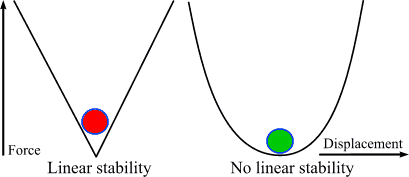
HexDome
Hexagonal Geodesic Domes
Stability
One of the things that we often want to know about a
physical structure is whether it is stable or not.
The term stability usually refers to whether something
maintains its state in the face of small perturbations.
In the context of static mechanical systems, it is
conventional to consider stability in terms of the response
of the system to small spatial displacements of its
component parts.
Assessing stability
The stability of a structure can be essayed empirically and
analytically:
- Empirical assessment typically consists of building or
simulating the structure, subjecting the result to small
perturbations - and looking at how it responds.
- Analytical assessment usually involves an examination
of the equations of motion that govern the forces on an
abstract model of a structure when it is perturbed.
While empirical assessments are invaluable, the rest of this
essay is about analytical assessment of stability.
Types of stability
There is more than one flavour of stability. As a brief overview:
There are static and dynamic stability. A gyroscope can have
a type of stability when in motion which would not show up
in a static stability analysis of its components. This essay
will only deal with static stability.
There's asymptotic stability, and Lyapounov
stability:
- Lyapounov stability refers to systems where
the system remains in a neighbourhood of the equilibrium
position after perturbation.
- Asymptotic stability describes
systems where equilibrium is increasingly closely approached
after a perturbation.
In practice, real physical systems tend to be damped - and
thus exhibit asymptotic stability - though models of
them can exhibit Lyapounov stability.
Then there's linear and non-linear stability:
- Linear stability analysis takes a first order
approximation of the differential equations governing motion
- by simply discarding higher order terms from their Taylor
series expansion - and considers the stability of the
resulting simplified system.
- If a system lacks linear stability, non-linear analysis
may still find it exhibits a kind of stability after higher
order terms are considered.
The notion of linear stability is very useful importance
when considering the stability of physical structures.
Linear stability analysis
The basic idea of linear stability anaysis is simple, throw away
all the higher order terms in the equations of motion and
consider the stability of the resulting linear system.
The main idea behind this approach is to simplify the
analysis - and get a reasonable quality answer quickly.
Often a linear stability analysis will tell you most of what
you need to know about the stability of a structure.
If the resulting linear system is stable - and the restoring
forces are large enough - consideration of higher order
terms is unlikely to add much to the conclusion.
On the other hand, a system which is not linearly stable is
likely to have some sort of stability problem - even if
analysis of higher order terms indicated that there is still
a type of of non-linear stability present.
A diagram should help illustrate the notion of linear stability:

Linear stability in a nutshell
The red ball illustrates a system with linear stability. Any
perturbation results in a force which acts to restore the
stable position. The magnitude of the force is proportional
to the distance moved through.
The green ball illustrates a system lacking linear
stability. While displacements do result in forces
that act to restore the stable position, smaller perturbations
result in disproportionally smaller restoring forces - and
the first derivitave of force with respect to displacement
is zero.
In other words, the limit of dF/dx as
x -> 0 (where x is a measure of
displacement, and F is the magnitude of the
resultant force) is zero.
Linear stability is sometimes known as "first order stability".
In the terminology of rigidity theory, "linear stability"
refers to the shared property of those networks which are
rigid, and which lack infinitesimal
rigidity.
Vibrations
In the force diagram, if you imagine the balls as moving in
physical valleys with the shape of the curves, you can see
that the system lacking linear stability is likely to be
more prone to oscillations.
This is a quite general phenomenon: systems lacking linear
stability are prone to oscillations and vibrations.
A classic example of a system lacking linear stability is
a guitar string.

Small perturbations change the string's length only slightly
There a small transverse perturbation results in a restoring
force proportion to the degree to which the string has been
extended, which goes roughly according to the it's the
cosine of the angle it has been moved through, minus one.
The Taylor expasion of Cosine goes: cos(x) = 1 - x^2/2 + x^4/24...
Subtract one and you get a restoring force which is proportional
to:x^2/2 - x^4/24 - an expression which has no linear
term.
Consequently a guitar string is relatively free to exhibit
small oscillations - since there is practically no restoring
force opposing such small scale movements.
The result is a system which is prone to small-scale vibrations.
Linear stability - example
To give an example of a structure which is not linearly stable,
consider a bicycle wheel with radial spokes:

Radial spokes result in a wheel which is not linearly stable
Here the hub resists translational movements - but presents
little resistance to small perturbations which rotate the
rim about it's own axis while holding the hub still.
In this example, with an angular perturbation of Theta, the
limit of dForce/dTheta - as Theta tends towards
zero - is zero.
Such a layout would be especially bad in a rear driving
wheel - or in a wheel equipped with a disc brake.
The bicycle illustrated above has no disc brakes - and uses
a different configuration of spokes in its rear wheel.
Non-linear stability analysis
As the examples illustrate, systems lacking linear stability
can still be useful structures.
The non-linear forces may increase rapidly enough for them
to be effective at keeping the system near the stable state.
Alternatively, oscillations may not matter:
In the example of the bicycle wheel, the oscillations are of
the hub, with respect to the rim. However, such
oscillations do not have much functional effect in the
context of such a wheel. They may perhaps accelerate the
progress of metal fatigue in the spokes - but spokes have to
resist such forces anyway: they are a natural part of the
normal function of the wheel.
Similarly systems which do have linear stability
may have restoring forces which are too weak for them to be
effective at maintaing structural stability in the face of
perturbations on the scale which can be expected.
In such cases, a more complex analysis may be needed - one
that considers more than simply the linear component of the
restoring forces.
Tim Tyler |
Contact |
http://hexdome.com/
|